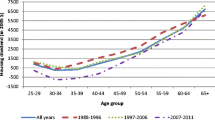Abstract
Personal preferences and financial incentives make homeownership desirable for most families. Once a family purchases a home they find it impractical (costly) to frequently change their ownership of residential real estate. Thus, by deciding how much home to buy, a family constrains their ability to adjust their asset allocation between residential real estate and other assets. To analyze the impact of this constraint on consumption, welfare, and post-retirement wealth, we first investigate an individual’s optimal asset allocation decisions when they are subject to a “homeownership constraint.” Next, we perform a “thought experiment” where we assume the existence of a market where a homeowner can sell, without cost, a fractional interest in their home. Now the housing choice decision does not constrain the individual’s asset allocations. By comparing these two cases, we estimate the differences in post-retirement wealth and the welfare gains potentially realizable if asset allocations were not subject to a homeownership constraint. For realistic parameter values, we find that the homeowner would require a substantial increase in total net worth to achieve the same level of utility as would be achievable if the choice of a home could be separated from the asset allocation decision. The robustness of the analysis is evaluated with respect to the model’s parameters and initial state variables. We find that changes in the values of the constraint (i.e., the value of the home) and the expected real rate of home value appreciation are the only state variables or parameter that is associated with a large change in asset allocation and/or the burden imposed by the housing constraint. This finding suggests the importance of a detailed examination of the impact of inter-regional differences in home prices and expected rates of appreciation on asset allocation and post-retirement wealth.
Similar content being viewed by others
References
Bertaut, C., & Haliassos, M. (1997). Precautinary portfolio behavior from a life-cycle perspective. Journal of Economic Dynamics and Control, 21, 1511–1542.
Cauley, S., & Pavlov, A. (2002). Rational delays: The case of real estate. Journal of Real Estate Finance and Economics, 24(1/2), 143–165.
Chetty, R., & Szeidl, A. (2004). Consumption Commitments and Asset Prices. Working Paper.
Cocco, J. (2005). Portfolio choice in the presence of housing. Review of Financial Studies, 18, 535–567.
Flavin, M., & Yamashita, T. (2002). Owner-occupied housing and the composition of the household portfolio. The American Economic Review, 92, 345–363.
Glaeser, E., & Shapiro, J.( 2002). The Benefits of the Home Mortgage Interest Deduction. NBER Working Paper, No. 9284.
Grossman, S., & Laroque, G. (1991). Asset pricing and optimal protfolio choice in the presence of illiquid durable consumption goods. Econometrica, 58, 25–51.
Guiso, L., Jappelli, T., & Terlizzesse, D. (1996). Income risk, borrowing constraints and portfolio choice. The American Economic Review, 86, 158–172.
Gyourko, J., & Sinai, T. (2003). The spatial distribution of housing-related ordinary income tax benefits. Real Estate Economics, 31, 527–575.
Heaton, J., & Lucas, D. (1999). Market frictions, saving behavior and portfolio choice. Macroeconomic Dynamics, 1, 76–101.
Kullmann, C., & Siegel, S. (2003). Real Estate and its Role in Household Portfolio Choice. Working Paper The University of British Columbia.
Leonhart, D. (2003). Around U.S. a House is a Home but not a Bonanza. New York Times. August 6, 2003.
Marshall, D., & Parekh, N. (1999). Can costs of consumption adjustments explain asset pricing puzzles? Journal of Finance, 52, 623–654.
Merton, R. (1971). Optimum consumption and portfolio rules in continuous time model. Journal of Economic Theory, 3, 373–413.
Piazzesi, M., Schneider, M., & Tuzel, S. (2003). Housing Consumption, and Asset Pricing. Working Paper.
Poterba, J., & Samwick, A. (1997). Household Portfolio Allocation Over the Life Cycle. NBER Working Paper, No. 6185.
Siegel, A. (2004). Consumption-Based Asset Pricing: Durable Goods, Adjustment Costs, and Aggregation. Working Paper.
Sinai, T., & Souleles, N. (2003). Owner-occupied Housing as a Hedge Against Rent Risk. NBER Working Paper, No. 9462.
Yamashita, T. (2003). Owner-occupied housing and investment in stocks. Journal of Urban Economics, 53, 220–237.
Yao, R., & Zhang, H. (2005). Optimal consumption and portfolio choices with risky housing and borrowing constraints. Review of Financial Studies, 18, 197–239.
Yugo, M. (2003). A Consumption-Based Explanation of Expected Stock Returns. Working Paper.
Author information
Authors and Affiliations
Corresponding author
Rights and permissions
About this article
Cite this article
Cauley, S.D., Pavlov, A.D. & Schwartz, E.S. Homeownership as a Constraint on Asset Allocation. J Real Estate Finan Econ 34, 283–311 (2007). https://doi.org/10.1007/s11146-007-9019-9
Published:
Issue Date:
DOI: https://doi.org/10.1007/s11146-007-9019-9



